antiAtlas #5 - 2022
Extra-territorial voices: Language interpreting practices in the waiting zone of Roissy-Charles-de-Gaulle airport
Maxime Maréchal
Translation: Rosemary Masters
Abstract: The waiting zone in Roissy-Charles-de-Gaulle airport is a key space for border police action in denying foreigners admission to French territory. Approaching it as an acoustic environment enables us to understand the crucial part played by sound in the network of power relationships that are in operation here. In particular, language interpreting practices are central to the meeting of police and politics at the border.
Maxime Maréchal is a PhD candidate in sociolinguistics at Université Paris Cité. His research is partly funded by the association ISM-Interprétariat (CIFRE system). He is a volunteer at Anafé (Association Nationale d’Assistance aux Frontières pour les Étrangers) and a fellow of the French Collaborative Institute on Migration.
Keywords: Waiting zone, language interpreting, acoustic environment, sociolinguistics, asylum process, borders
antiAtlas Journal #5 "Air Deportation"
Directed by: William Walters, Clara Lecadet and Cédric Parizot
Design: Thierry Fournier
Editorial office: Maxime Maréchal
antiAtlas Journal
Director of the Publication: Jean Cristofol
Editorial Director: Cédric Parizot
Artistic direction: Thierry Fournier
Editorial Committee: Jean Cristofol, Thierry Fournier, Anna Guilló, Cédric Parizot, Manoël Penicaud
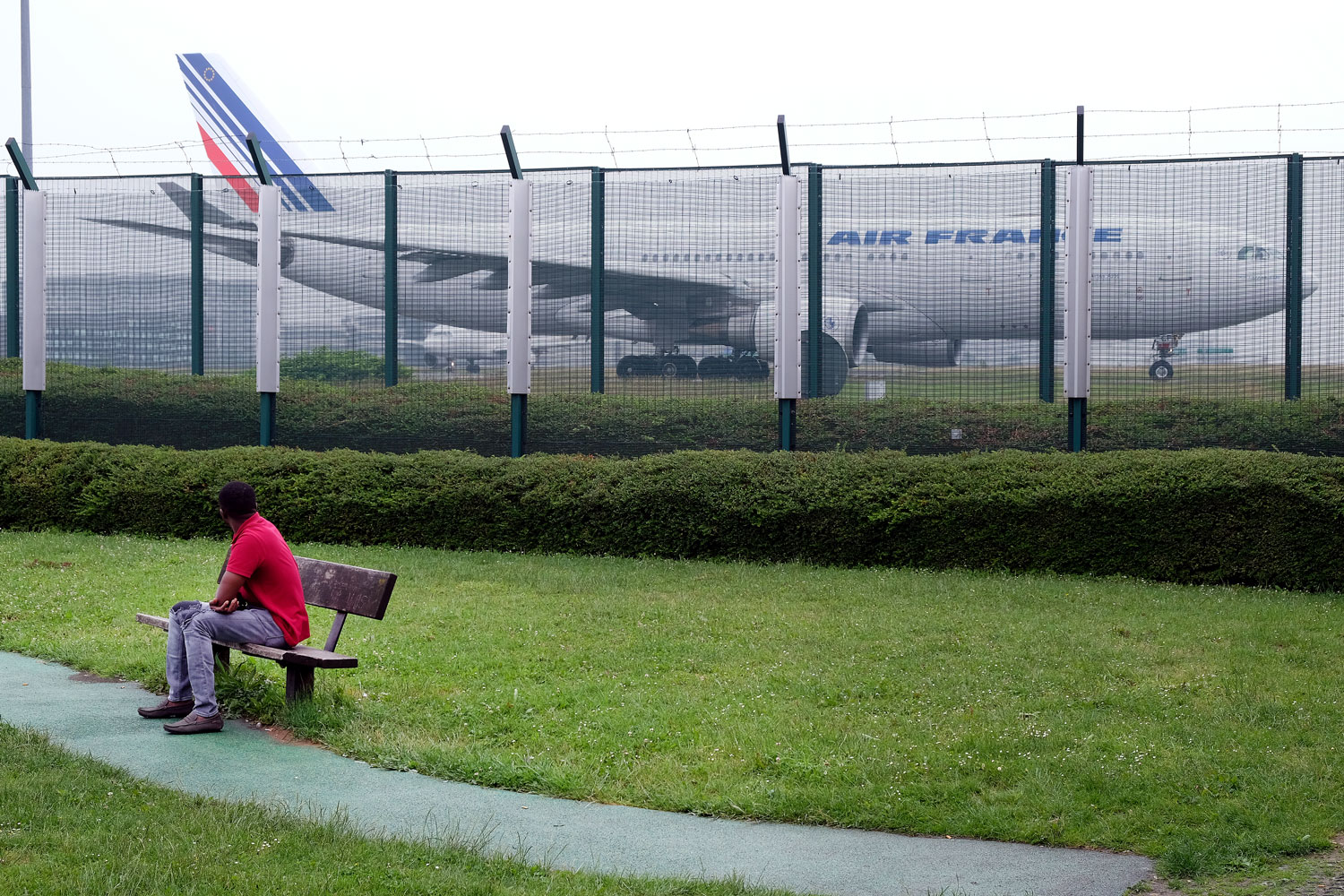
Photo: JC Hanché for CGLPL (Contrôleur Général des Lieux de Privation de Liberté - an independent public body in charge to control all the places where people are deprived of liberty, and check that all the fundamental rights of people in these places are)
To quote this article: Maréchal Maxime, "Extra-territorial voices: Language interpreting practices in the waiting zone of Roissy-Charles-de-Gaulle airport" published on June 1st 2022, antiAtlas #5 | 2022, online, URL: www.antiatlas-journal.net/05-marechal-extra-territorial-voices-language-interpreting-practices-in-the-waiting-zone-of-roissy-charles-de-gaulle-airport, last consultation on Date
I. The waiting zone at Paris-Charles-de-Gaulle: a node in the border system
A. Situating the waiting zone
1 The waiting zone is the zone for detaining people whom the border police consider to be “inadmissible” onto French territory. They are held here until they are either returned to the airport from which they came or are admitted into France.
The waiting zone is a hub in the “continuum” linking European migration policies to the procedure for seeking asylum in France.
The ways of leaving the waiting zone should not hide its principal aim, which is the expulsion of “illegalised migrants” (Bauder, 2014). Legally introduced in 1992, the waiting zone is a hub in the “continuum” linking European migration policies to the procedure for seeking asylum in France (Clochard, 2007). It is responsible for filtering movement according to the dichotomy between economic and political motives for migration that is frequently cited in the politico-media field in defence of the right to asylum (Brice, 2019).
Since then, it has become “one of the many devices crafted by States to keep asylum claimants away from their territory and constitutes the last non-entrée mechanism when all the upstream ones have failed” (Maillet, 2020: 15).
next...
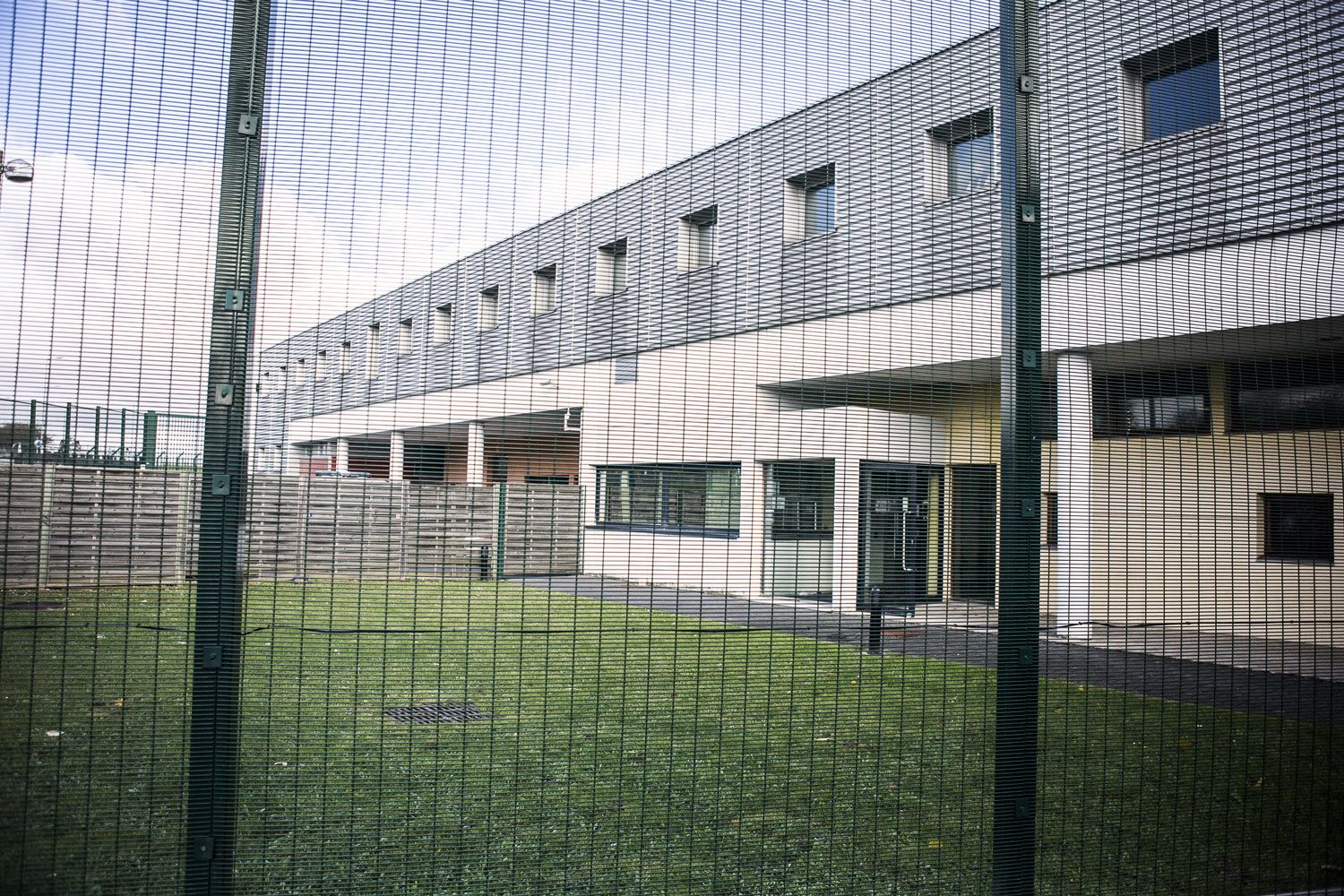
Photo: Yann Castanier/Hans Lucas
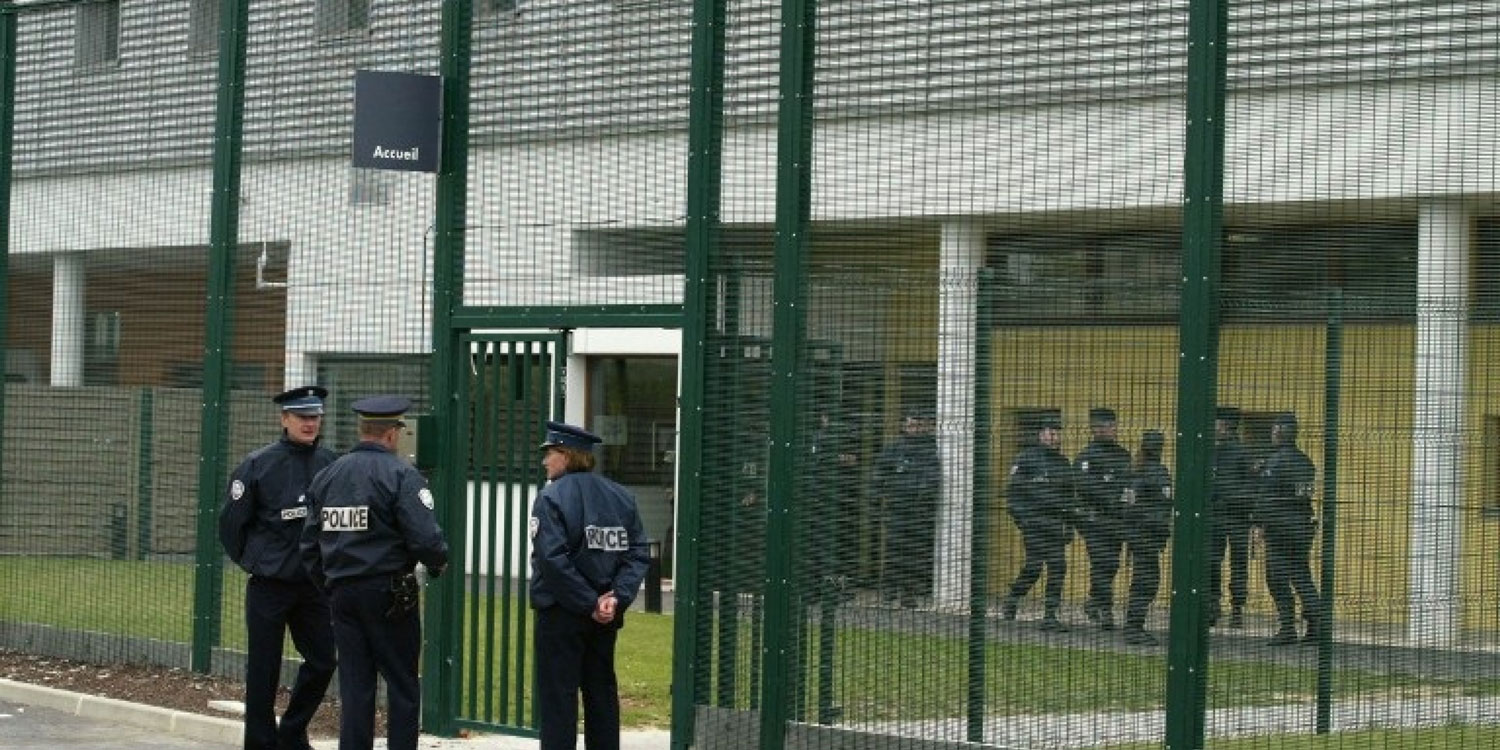
Photo: JC Hanché for CGLPL
2 The temporary nature of the deprivation of liberty in the waiting zone plays a part in its “malleability” (Iserte, 2009). Indeed, “the time frame of procedural delays overlaps with the daily routine of detention” (Makaremi, 2007) in a testing combination of waiting and urgency. The alternatives of expulsion and authorised access cover very varied situations both during and after holding.
This “extra-territoriality” legitimises a range of “exclusionary practices taking place within States’territories”
Some people become subject to administrative “ping-pong” between the waiting zone and the airport in their country of origin which also refuses to admit them; others, increasingly numerous, find themselves in a “vicious circle of detention" (Anafé, 2020b: 14) in which they are deprived of liberty for a period well beyond the twenty days that are set as the limit for people to be in the waiting zone.
The waiting zone is a “nowhere land” (Bourguet, 1992) where people are rapidly given various statuses. Under the heading of inadmissibility, and in the space of only a few days, a person may be categorised as “refused entry” or “in suspended transit”, “asylum seeker” and then – if his asylum request is not granted – he may again be categorised as “refused entry” and thus expellable. This condensing in space and time of “paper careers” (Spire, 2005) entails a special regime for those held, as against those detained (on national territory). This “extra-territoriality” legitimises a range of “exclusionary practices taking place within States’ territories” entailing a reduction in rights, notably for asylum seekers and unaccompanied minors (Maillet, 2020).
The greatest number of both detainees and asylum interviews at the border – 70% of asylum requests in 2020 (OFPRA, 2021) - are concentrated in the waiting zone known as ZAPI 3, at Roissy-Charles-de-Gaulle airport. Conceived by France as a “showcase” for other waiting zones, various agencies, such as Anafé, the Red Cross and even a doctor - have set up there. In 2017 an annex of the Bobigny law court was specially built in an extension of the building. The way in which this space is organised demonstrates the many stages along the administrative journey for detainees, and the speed at which they pass through them.
next...
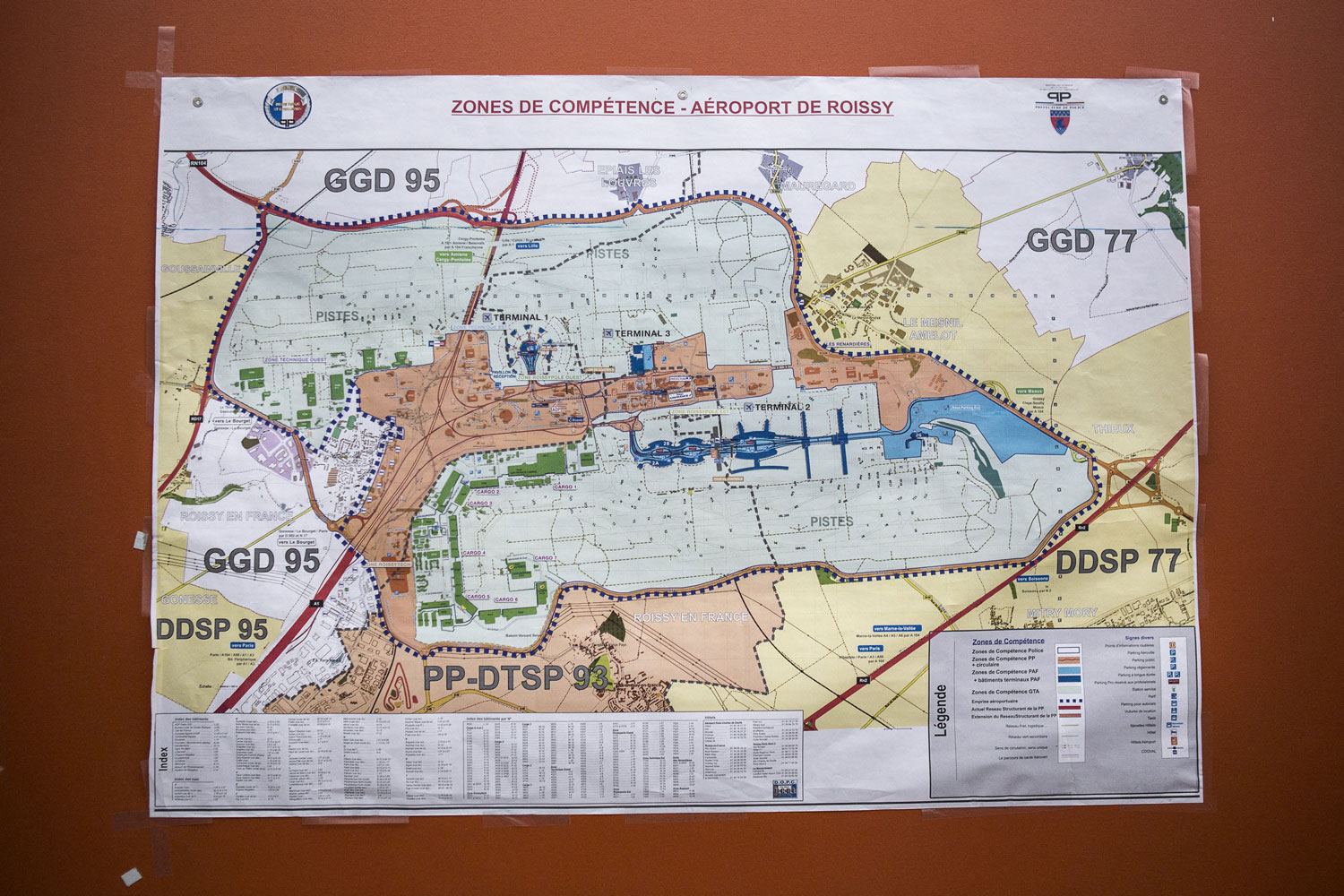
Photo: Yann Castanier/Hans Lucas
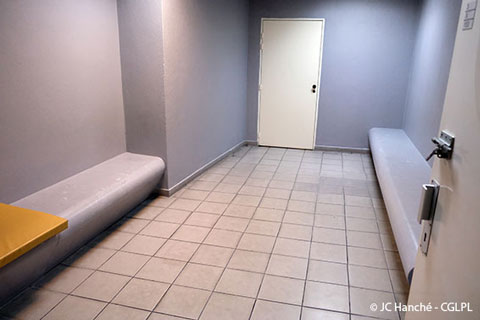
Photo : J.C. Hanché for CGLPL
B. Listening at/to the border
3 The waiting zone is thus configured as a place that is both marginal and central in the management of the spatial and administrative movement of foreigners pronounced illegal entrants at the border. Indeed, the apparently marginal areas of the country are the places where its sovereign powers are most strongly in evidence and where the practices of its agents show the greatest divergence from the norms that are supposed to frame them (Fassin et al., 2013). In order to understand this hidden centrality, surveys of the waiting zone are principally concerned with the issue of visibility. Militant reports defend access by associations, asking “What are the border police hiding?” and denounce “the invisibilisation of waiting zones and of those who are held therein” (Anafé, 2020: 27). Academic research is faced with difficulties relating to the “occultation” of this space (Maillet et al., 2017). “Marking out borders” thus seems to be both a political and an epistemological issue for interrogating the perception and production of borders by the various actors. But to do this, it is essential to suggest “interdisciplinary, theoretical and methodological approaches to borders that thus resonate with what they are proposing to study” (Auzanneau and Greco, 2018). Thereafter, the dialectic of the visible and the invisible as the only way to approach the border should be interrogated.
Attention to sound aims at a more subtle understanding of the procedural and relational character of border dynamics
Focussing on the question of what is visible seems in fact to have entailed less attention being given to what is heard. Yet the sound of the border has been increasingly covered in border studies by works that critique the epistemological prevalence of vision in analyses of borders and even in social sciences in general. Paying attention to sound aims at a more subtle understanding of the procedural and relational character of border dynamics, in that sounds arise from multidirectional vibrations and have different effects on those who produce them and those who receive them. Soundborderscapes – recordings made at borders – allow us to question the ”traditional interpretation of the border as a line of separation” in order to “not only amplify and “make audible” the processes that take place at the border – or the border itself as a process – but also propose listening as a useful instrument for a critical epistemology of the border” (Biserna, 2017). An analysis of the sounds of the relationships between border authorities and migrants can show the border as a “panaudicon” (in reference to Foucault’s “panopticon”), articulating in a variety of ways “sound-based security politics” (Weitzel, 2017: 6) on an individual scale.
next...
4 Visual tropism in research on borders could explain the fact that language issues, while crucial in the context of migration (Galitzine-Loumpet and Saglio-Yatzimirsky, 2020), play little part in studies of the waiting zone, even though plurilingual language practices are critical and involve different contexts, actors and languages.
Plurilingual language practices are in fact central to the administrative path of detainees in ZAPI 3
Over and above their role in the material sound of the border, plurilingual language practices are in fact central to the administrative path of detainees in ZAPI 3. This is clear in the legal measures providing for the use of an interpreter, and also in the frequent denunciation by Anafé of failures in “interprétariat” (Anafé, 2018, 2020), a French term best translated as simply “interpreting” which is less disparaging (Navarro, 2013) but has the same meaning: the consecutive, oral translation by an interpreter of the statements made by two speakers in different languages. If the role of interpreters is often neglected by studies of asylum policies in France, it has nonetheless been studied within the context of associations supporting exiles (Clappe, 2019), the French National Court of Asylum (Pian, 2020), and in non-institutional situations (Galitzine-Loumpet and Saglio-Yatzimirsky, 2019); but not in the waiting zone. As for the rare works of literature specialising in interpreting which take an interest in the context of the border, they show a wholly visual take on the subject by basing their analyses on photographs featuring interpreters in historic conflict situations (Fernández-Ocampo and Wolf, 2014) or in humanitarian transborder action (Nuč and Pöllabauer, 2021).
next...
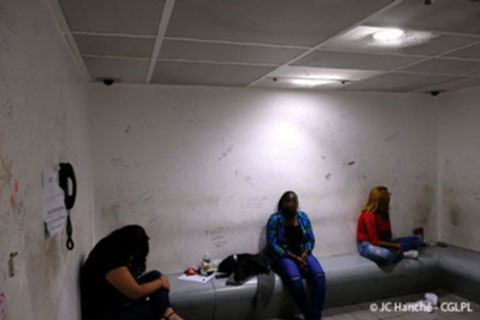
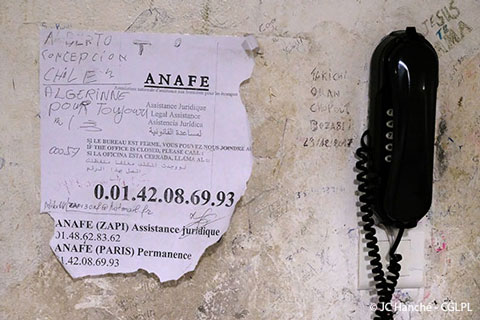
Photos: J.C. Hanché for CGLPL
C. The waiting zone: an obscured place
5 ZAPI 3, like other “obscured places” on the border (Maillet et al., 2017), presents political, ethical and methodological obstacles. Access is limited to certain authorised associations, one of which is Anafé, principally for its legal service. Researchers and volunteers must therefore avoid compromising this, which makes it difficult to “participate by observing” (Makaremi, 2008) in this area: picking up signs of the violence suffered by detainees without making their situation worse, and at the same time trying to give them legal assistance but, given the urgency and the number of demands during certain office hours, without replicating the administrative evaluation criteria which the action of associations risks incorporating by isomorphism with institutions (D’Halluin-Mabillot, 2008).
Those providing interpreting services are in a particularly delicate position. Professional interpreters are kept away from ZAPI 3 since they only operate by phone, whereas they are present at asylum interviews at the Office for the Protection of Refugees and Stateless Persons – or at least they are visible in interviews held by videoconference. This arrangement replicates the opacity and silence in which ZAPI 3 is placed by the administration: when contacted by telephone, the manager of the interpretation and translation service which had won the border police contract for providing services at police posts in the various terminals at Roissy airport, told me that he could not grant me interviews because of the duty of confidentiality imposed on his company, and that I should apply to the Ministry of the Interior.
Attempting to understand the place of interpreting practices as acoustic relationships in the context of border control.
Furthermore, both audio and video recordings are strictly forbidden in ZAPI 3. That does not, however, mean that voices in transit are destined to be ignored: an ethnography of ZAPI 3 via many of Anafé’s legal assistance sessions, interviews with interpreters who had operated in the waiting zone and an analysis of the legal and institutional framework of interpreting, make it possible to understand the place of interpreting practices in the structure of relationships in ZAPI 3 seen as an “acoustic environment”. Additionally, it is not a question of “describing a soundscape or studying the ecological or bioacoustic relationships between individuals and their environment, but rather of understanding how relationships of sound can establish social relationships” (Féraud, 2010: 239). Understanding ZAPI 3 as a border acoustic environment is thus not to reduce it to “a mere geography around language data” (Boutet, 2008: 102) but to attempt to understand the place of interpreting practices as sound relationships in the context of border control.
next...
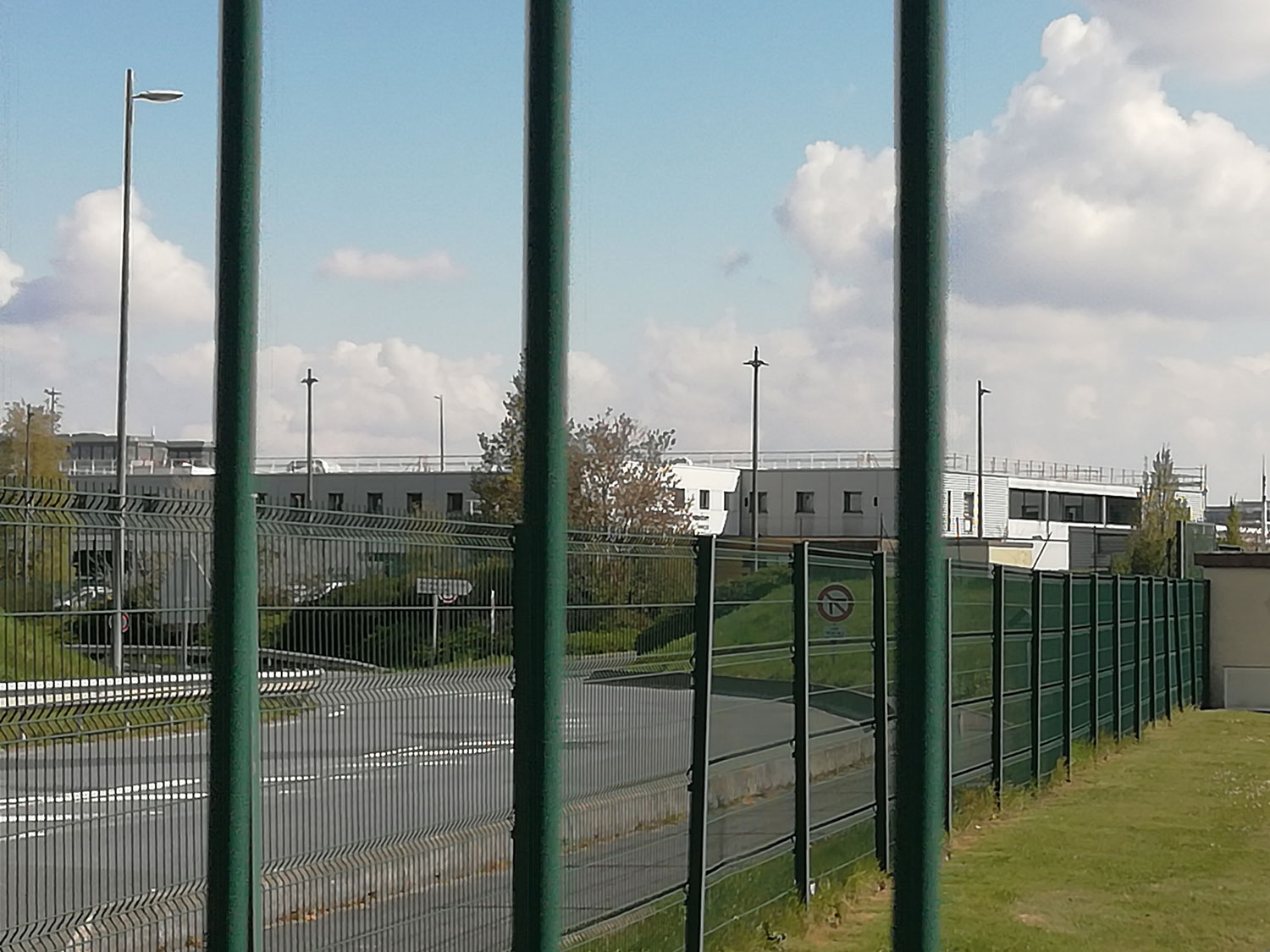
Photo: Maxime Maréchal
II. Interpreting (at) the border
A. ZAPI 3 as an acoustic environment
6 According to an approach that is sensitive to the sound materiality of the border: “Understanding sound as a vibrational force that affects matter around it highlights not only sound’s function as an actant in its own right, but also sound’s positionality within the network of power relationships that envelop it, produce it, and are impacted by it” (Weitzel, 2018: 5). In order to understand sound as an “actant” within ZAPI 3 and thus to place it in the network of power relations which are at work there, we must begin by presenting the principal sources which make up the acoustic environment: telephones, loudspeakers, aeroplanes.
Rows of wall-mounted telephones are found throughout ZAPI 3, mainly at the intersections of corridors that lead to the rooms. As mobile phones with a camera are confiscated by the police during the period of detention, these telephones are, for most people, their only means of oral communication with the outside world. Apart from a few calls, the only way of continuing to use them is by buying a phone card from the Red Cross, which means having to have cash, or relying on the generosity of other detainees. Phone calls are used for sharing news with relatives or for trying to find help, mainly by contacting a lawyer or Anafé if the Paris office is on duty. Phones also enable people to receive calls from relatives who call back on a particular telephone or from Anafé volunteers (or sometimes lawyers) who call at random to offer help; in this last case, contact depends on someone being in the vicinity at the time of the call, and on their decision to answer it.
Phone calls are thus part of the more general acoustic environment of ZAPI 3. These sounds are indeed interwoven and even compete with one another: as was mentioned by one man while on duty, it can be difficult to communicate by phone when the acoustic environment of the corridors is full of other calls being made at the same time, or because of people all around, particularly children. The subordinate position of these sounds in the network of power relationships which surrounds them, produces them and feels their impact is evident as soon as police announcements are made through the loudspeakers installed in the corridors. Most of the time, in fact, people stop talking to listen to the announcement, or wait for it to end so that they can be heard by the person they are talking to.
next...
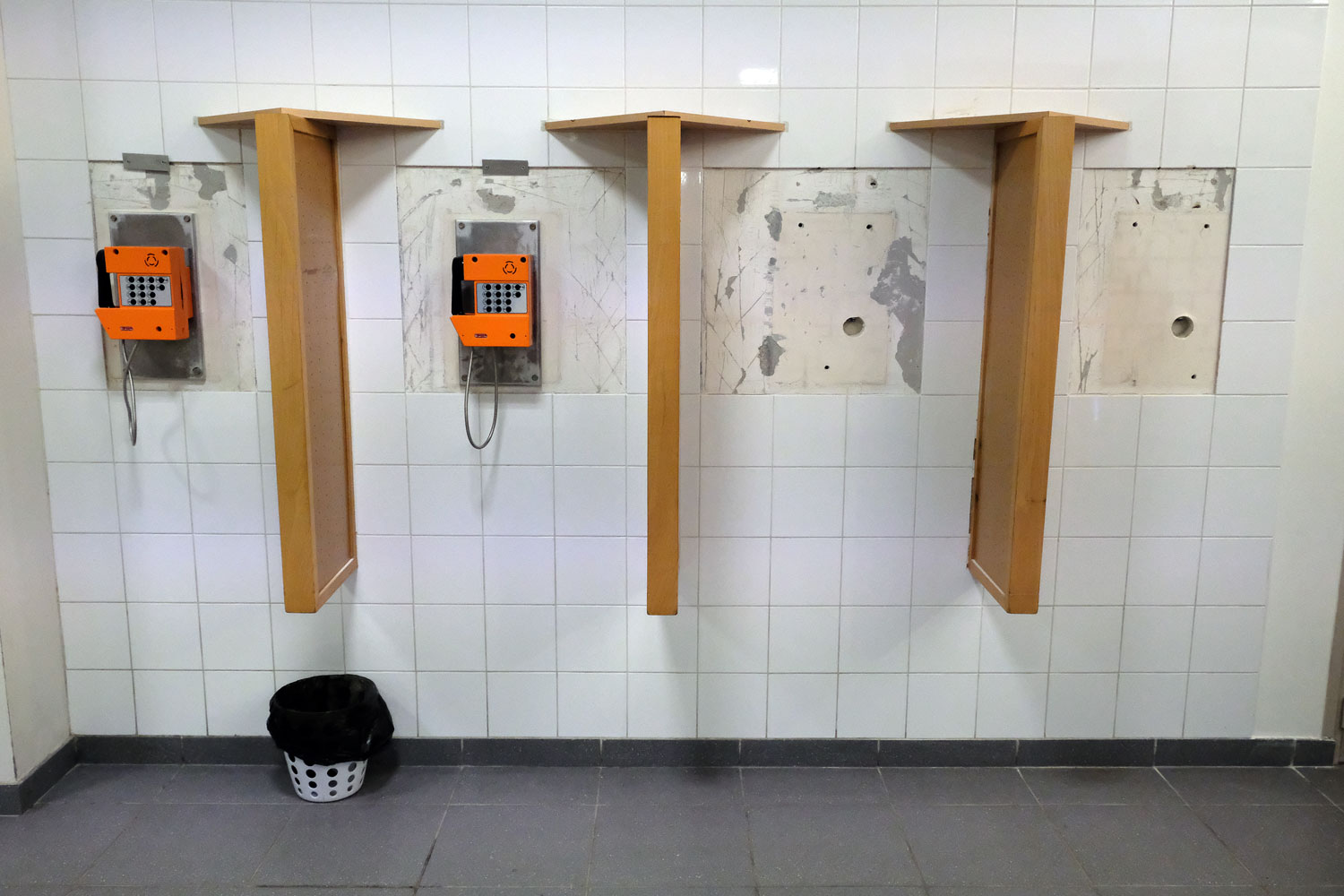
Photo: JC Hanché for CGLPL
7 These announcements are audible throughout the accommodation within ZAPI 3, both in the communal spaces and the relative privacy of the rooms. They call people to the police post, mainly for an OFPRA interview, to a court hearing, to the visitors’ room or for an attempt to send them back to the airport they came from; they can happen at any moment of the day or night. Based on an apparently standard formula stating the name of the person and the request to “come to the police post with official papers and luggage”, these announcements never give a reason and vary in their content (some police officers specify the nationality of the person after their name), in the language used (French or English) and in their prosodic features.
These one-sided signals demand people’s constant attention, as they may announce a new stage in the administrative process or raise the risk of being sent back. In the extended timescale of ZAPI 3, they represent the intrusion of urgency and threat. They have also been analysed as techniques for controlling people awaiting decisions, since repeated announcements in the middle of the night deprive people of sleep and thus reduce the possibility of resistance to being sent back (Makaremi, 2009).
Just as one-sided as the loudspeaker announcements, aeroplane noise is an instrument of “biopower” specific to ZAPI 3
ZAPI 3 is regularly disturbed by the noise of planes taking off. Resulting from the immediate proximity of the runways, these sounds are cited as a source of tension and anxiety for detainees (Anafé, 2018: 120). Consequently, they are a central part of the acoustic environment at the border, as they remind people of the extra-territoriality of the area in which they are being held. An ethnographic approach to British deportation policies shows that “Hearing planes coming and going was a constant reminder [to the detainee] that he was about to leave. In this sense, the IRC (Immigration Removal Centre) is already a transitional space where migrants, although physically in the UK, are compelled to feel themselves closer to their country of origin,” (Hasselberg, 2012: 106). This analysis of a sound creating a “transition space” can be transposed to the “nowhere country” where people are also compelled to “feel closer to their country” – their country of origin or the country from which they arrived. Just as one-sided as the loudspeaker announcements, aeroplane noise is an instrument of “biopower” specific to ZAPI 3 (Makaremi, 2009: 60): it is an acoustic “actant” in its own right which constantly weighs on people and reminds them of the constantly threatening prospect of being sent back.
In ZAPI 3 sounds are thus an inextricable part of the network of power relationships through their implication, their source and their impact. In these conditions, language interactions themselves occupy a place in this network of power relationships which cannot be characterised by their semantic content alone. Thus, interpreting is not reduced to a means of ensuring the rights of non-French speaking detainees; it contributes to the relationships in the acoustic environment of ZAPI 3 and so is part of the distribution of positions which the different sounds – and their different sources – occupy in the network of power relationships.
next...
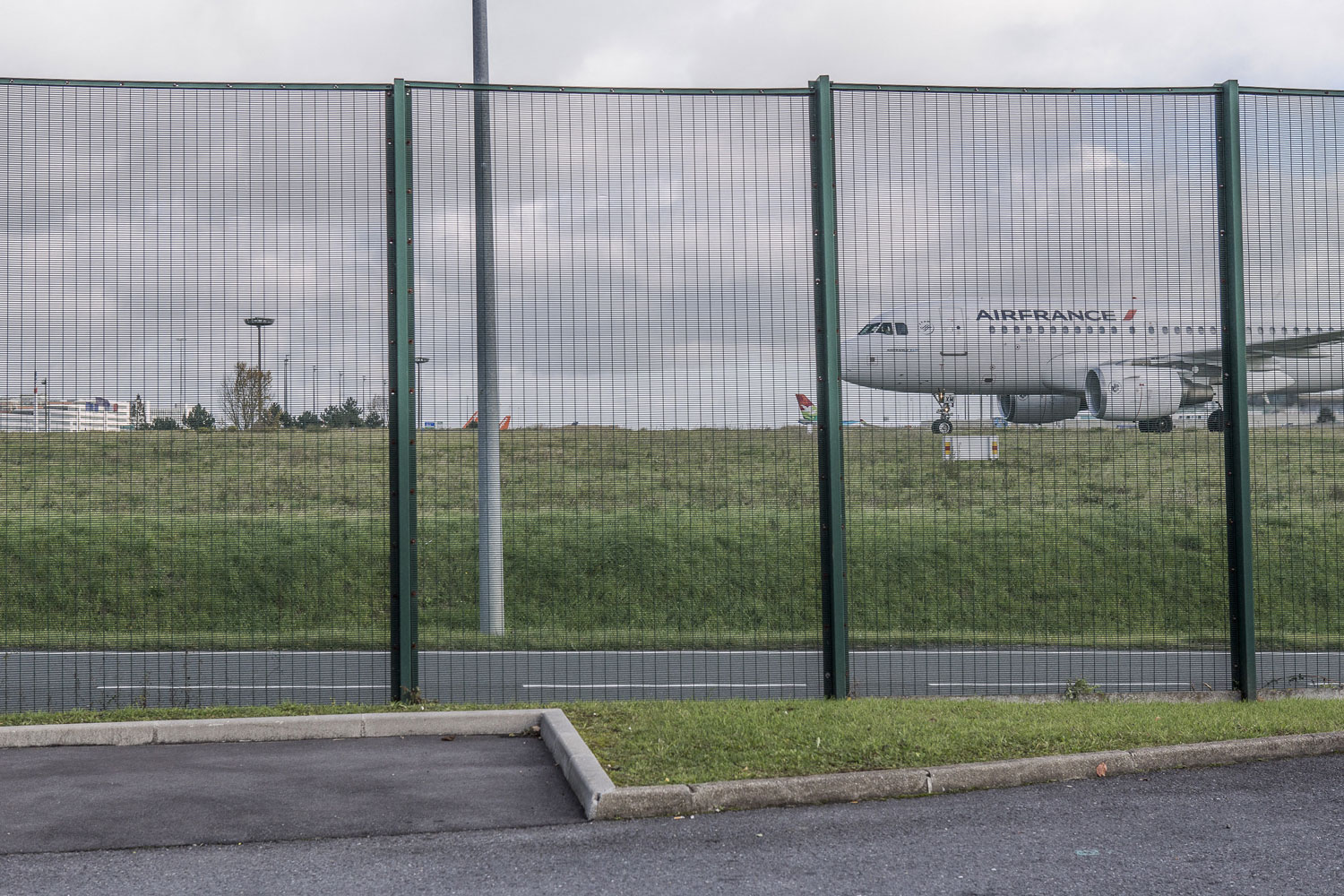
Photo Yann Castanier/Hans Lucas
B. OFPRA interviews in ZAPI 3: interpreting at the threshold of asylum
8 Several situations requiring an interpreter are set out in the procedure; the frameworks, modes and types of interpreting proliferate throughout the period during which people are held.
The use of interpreters is, according to a police captain responsible for several terminals, a “sort it out yourself regime”
An interpreter works by telephone or in person at the airport when notified by the police that a person has been refused entry. Linked to administrative demands (“get the numbers right”) the use of interpreters is, according to a police captain responsible for several terminals, a “sort it out yourself regime”: contrary to what is set out in the Interior Ministry’s procurement process, interpreters who are supposed to come in person nearly always carry out their service by phone, helping the police who produce the transcript to save time.
On the other hand, interpreters always come in person for detention hearings in front of a judge or for a tribunal appealing against a refusal of accessing the territory on asylum grounds. As in other legal interpreting situations, the interpreter may be registered as an expert by the court, but not necessarily. If not, less strict selection criteria are needed, since a simple oath sworn at the time of the hearing is sufficient for the interpreter to be accredited.
next...
9 But the situations in which the use of an interpreter is most regulated, legally and institutionally, in ZAPI 3 are the OFPRA “Mission of asylum at the borders” interviews. As with interviews taking place at their head office, the “cooperation” of an interpreter has become extremely common here: in 83% of cases in 2020 (OFPRA, 2021). Interviews at the border are different from those at head office: extremely brief, in the main, they only aim to set out advice for the Ministry of the Interior in relation to the admission into France of the asylum seeker being held, and thus are not meant to examine the reasons why the person left their country of origin. The protection officers who carry them out are part of a separate division and thus have less specialised knowledge of the regions from which asylum seekers come than of the specific arrangements for investigating such requests at the border. And interpreters only operate by telephone, which is a sign of the “extra-territoriality” (Maillet, 2020) in which these interviews are held.
The interaction of interpreters at OFPRA interviews in ZAPI 3 is defined by the aim of management efficiency that works for the control of movement governing the activity of the mission on border asylum
OFPRA has been responsible for these asylum admission interviews since 2003 when French law incorporated new concepts in asylum law (in particular that of “manifestly unfounded applications”) and made OFPRA the “only door to asylum” (Djegham, 2011). Having become “a veritable decision-making factory” according to its director at the time, OFPRA is thus an integral part of the overall means of controlling and expelling foreigners, since “The agents of the Foreign Ministry (then those of OFPRA from 2004 onwards), the guardians of the right to asylum in waiting zones, seem to work more in the spirit of guardians of the borders” (Clochard, 2007: 353). While interpreting was formalised by the law of 2003, which provided for the systematic use of an interpreter at interviews as well as procurement contracts for the languages to be interpreted, it was also with this law that the physical presence of interpreters in ZAPI 3 ceased to be obligatory.
Since then, the interaction of interpreters at OFPRA interviews in ZAPI 3 has been defined by the aim of management efficiency that works for the control of movement governing the activity of the mission on border asylum. This manipulation operates in regard to sound: the police can often be heard through the doors or windows of the offices of the mission on border asylum. Moreover, interpreting via telephone increases the isolation of asylum seekers, mainly because they cannot identify their interpreter: this decontextualization of sounds thus contributes to the confusion felt by many asylum seekers over the diversity of the roles and affiliations of those they are having to deal with. It accentuates even more their “linguistic vulnerability” (Määttä, Puumala, and Ylikomi, 2020). Also, many asylum seekers tell Anafé that their interviews are very short, and that the officers and interpreters tend to restrict what they say and hurry them through the interview. This typical tendency to “entextualisation” (Jacquemet, 2009) of what is said into an administrative format is reinforced by the use of a telephone; interpreters have in fact to make greater efforts to ensure understanding, which speeds up speech rhythms (Määttä et Wiklund, 2019). While the “bureaucratic format” of the asylum application interview (Maryns, 2006) may change the subjective content provided by the asylum seekers, it also largely determines the sounds they are able to make. Cut short, rushed: the very nature of the sounds produced indicates their reduced role in the acoustic environment of ZAPI 3 and consequently that of the people making them.
Interpreting in OFPRA interviews in ZAPI 3 thus provides an example of the reduction in the rights of asylum seekers in this area because of its extra-territoriality, such that it can be transposed to the acoustic network of positions of power. This can be seen in certain transcripts of interviews in which the protection officer notes in italics that “the subject uses a term [in a language] unknown to the interpreter”, or “interpreter does not understand”, or again, “answer incomprehensible according to the interpreter”, before moving on to another point in the asylum seeker’s account. These remarks show a tolerance of the failure to understand that would be unthinkable in interviews at the head office of OFPRA.
next...
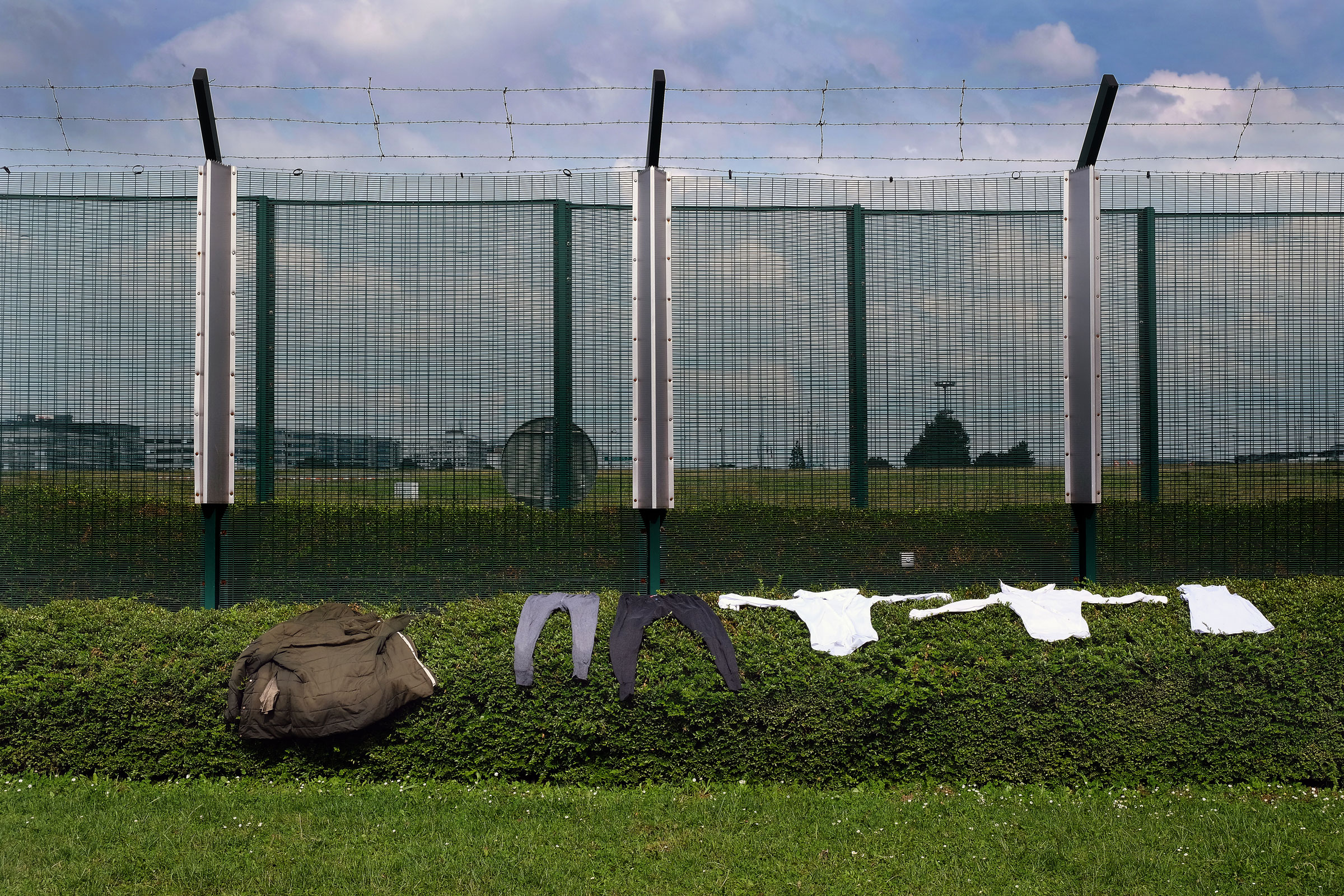
BIG Photo: J.C. Hanché for CGLPL
C. Interpreters involved in voluntary work
10 Interpreting, however, is not limited to institutional meetings that are part of the procedure. Anafé, for example, finds volunteer interpreters for specific phone calls. Militant action is for them often limited to this and is thus a particular form of involvement. While some works have described the subjectivation of exiles through their role as an interpreter for the association which initially helped them (Pian, 2017), this kind of involvement is not found in the associations that are present in the waiting zone.
I explained OQTF to the gentleman because this is not the first time I’ve worked with the police
At Anafé, interpreting thus takes precedence over volunteering, which is explained by the importance of interpreting needs, especially in certain languages. The role of these volunteer interpreters is much more important than that of the professionals (Navarro, Benayoun and Humbley, 2016). Some of them sometimes spontaneously provide explanations for detainees. One interpreter, for example, said “I explained OQTF to the gentleman because this is not the first time I’ve worked with the police”. Some even provide advice, like a Russian interpreter asked to communicate with a man who, with his family, was about to be “rerouted” and who said: “I therefore advised him to refuse to board the plane”.
While interpreting situations that are part of the procedure follow a standard format, ad hoc interpreting that takes place when Anafé volunteers are on duty takes on various forms in the sound environment of ZAPI 3. The organisation’s office is a former bedroom, divided into two, but with no partition wall, in which each of the two volunteers greet people; it is also the only room in ZAPI 3 with windows – barred – that can be opened. These sessions take place in a complex acoustic environment: the attention of the people awaiting a decision and those of the volunteers is divided between the phone calls (in the corridors or the office), their own conversations, knocking on the door, the noise of planes taking off (especially when the window is open) and the disruption caused by police announcements from the loudspeakers in the corridors.
This wide range of sounds results in a listening hierarchy. Under these conditions, the loudspeaker function on the phone is in fact rarely used, which prevents those conversing from being fully present with each other. The asylum seeker, blocking one ear in order to hear the voice of the interpreter coming from the phone glued to his other ear is thus, in the middle of all the other sounds around, emblematic of the way in which interpreting intermingles with sounds in ZAPI 3 when it is not carried out in an institutional setting. If you want to be heard it is therefore sometimes necessary to raise your voice and to listen carefully.
next...
III. How to be heard in nowhere country
A. The glottopolitical issues in interpreting
11 The acoustic environment at the border in ZAPI 3 is thus ruled by police and administrative processes which dominate via loudspeakers and the procedural calendar. The distribution of interpreting seems to replicate this asymmetry exactly, since interpreters are only called for in the context of institutional meetings or, as needed, for consultations with association volunteers in which appeals are formulated. But this analysis does not take into account the considerable diversity of both those involved and of interpreting practice. Indeed, this diversity is not only the object of a linguistic policy; it is also a field of action for glottopolitics. Linguistic policy is decided on and carried out by the state, which tries to “organise linguistic diversity” (Blanchet, 2012: 17). Glottopolitcs as a concept, on the other hand, leads beyond the purely normative level of language in order to understand in addition language practice – hence the root word glotto, which avoids distinguishing between language [langue] and speech [parole].
Understanding the gap between interpreting norms – which in particular define the status of interpreters and the context of their work – and the ways in which these norms are effectively carried out.
Glottopolitics emerges from a state-centred context in order to shed light on the diversity of actors, since this concept “comprises both agreed policies and the stages, conscious or unconscious, active or passive, of these policies” (Guespin and Marcellesi, 1986: 15). This concept also allows us to analyse both the macro-sociolinguistic scale of linguistic policies and the micro-sociolinguistic scale of language practice which position themselves accordingly, and thus “to encompass all language events where the action of society takes on political form” (Ibid: 5). Applied to interpreting, this theoretical perspective thus invites an understanding of the gap between interpreting norms – which in particular define the status of interpreters and the context of their work – and the way in which these norms are effectively carried out.
Although the “sort it out yourself” approach of the airport police seems to conform to the requirement to use an interpreter, it thereby shows that interpreting is above all provided for the administrative performance sought by the border police. The management of interpreting during interviews for OFPRA’s mission on border asylum in ZAPI 3 also poses this kind of question: while the systematic use of an interpreter for non-French speakers is required by law, there is no legal ruling for or against the systematic use of the telephone. It is therefore an institutional choice, linked to OFPRA’s mission to classify applicants arriving at the border; the telephone thus becomes an instrument for, and a sign of, keeping detainees at a distance.
Since it relates to being heard, both in the sense of being understood and being listened to, interpreting in ZAPI 3 centres around the power relationships in the acoustic environment. And if it can be linked to police and administrative processes, it can also become an area for decision and even action.
next...
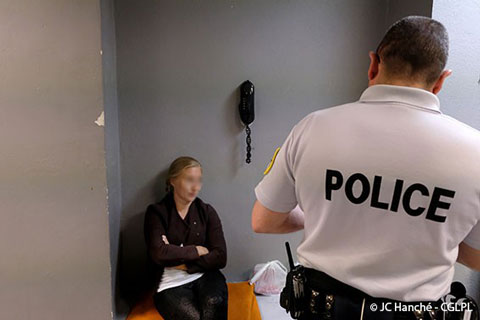
Photo: J.C. Hanché for CGLPL
12Interpreters working in OFPRA interviews are therefore in a different situation as regards the systematic use of the telephone. Some, while recognising that it is a technical difficulty, still consider that it is “exactly the same thing as at Fontenay”, that is to say, when they attend at OFPRA head office. Others are not even necessarily conscious of the context of their work, as is shown by the question asked by an interpreter at the end of an interview who asked “where” the conversation had just taken place.
“But it isn’t humanly possible for me to do that all the time, I would… It would be emotionally draining for me”
Several interpreters expressed their reticence or even disapproval, as one of them told us: “You have no idea what the person on the end of the line is like, and that’s a problem for an interpreter when beginning an interview, because it isn’t just aural, and for me, [name of the interpreter] even if I do this work, it’s not a problem, I can do it, I’ve done it and I’ve translated via telephone, I’ve done telephone interviews… But it isn’t humanly possible for me to do that all the time, I would… It would be emotionally draining for me”. That interpreter saw an interview limited to aural interaction as “emotionally draining” and “humanly” difficult. She was thereby critical of the regulations governing her work and was clearly conscious of the acoustic asymmetry in which asylum seekers in ZAPI 3 found themselves, considering – like several other interpreters – that it was “inhuman” to carry out asylum interviews in this context. These reactions to the distancing effect of the telephone show that professional interpreters themselves are not simply technical operators: on an individual level, they vary in the way they see the role given to them in the acoustic environment of ZAPI 3.
Interpreting can even be banned, which is a sign of its close links to the position of those working in the acoustic environment. In a collective article, a researcher (Maillet, Mountz and Williams, 2017) reported the following situation: she had access to ZAPI 3 because of her affiliation to Human Rights Watch, which meant that she was only allowed to visit the buildings. Unlike Anafé volunteers – whose work is regulated by a 2004 agreement between the association and Ministry of the Interior – she was forbidden to deal with the “individual situations” of detainees. On one of her visits, as she was passing the Anafé office, some detainees arrived, wanting to testify to police violence; but as they and the volunteers had no common language, the latter asked the researcher to interpret for them. Although she was aware of the problems that her decision could cause to her association and thus the risk involved to her own accreditation for visiting ZAPI 3, she nonetheless agreed. The decision to interpret or not therefore depended directly on the role of the researcher in the acoustic environment: since in her position she was formally forbidden to speak for detainees, her action risked bringing about her exclusion from ZAPI 3.
next...
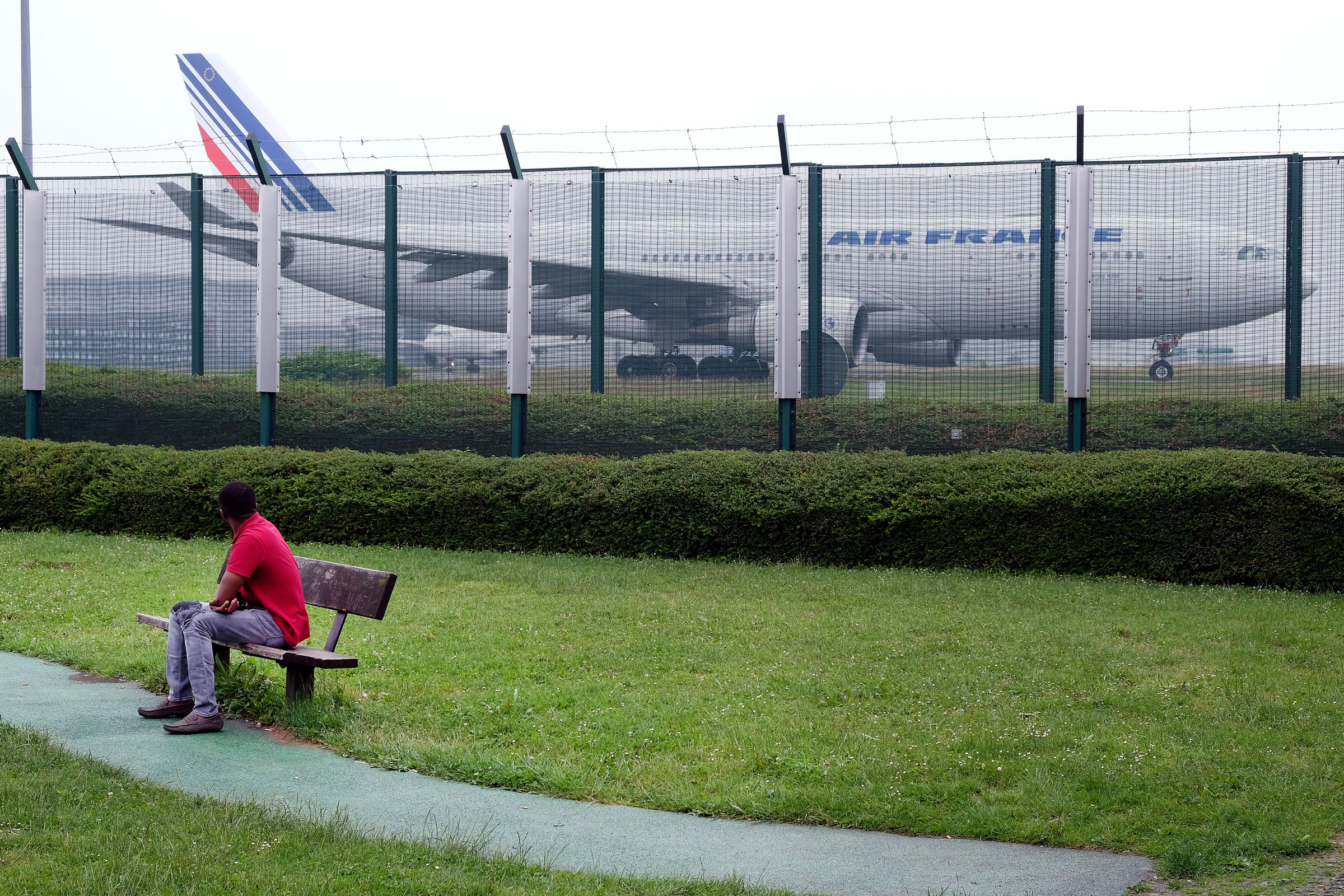
Photo: J.C. Hanché for CGLPL
B. Finding a voice
13 Detainees themselves show agency in situations where languages are involved. This can be simply a case of adapting to circumstances. In their OFPRA interview some asylum seekers prefer using French which, while not being their first language, does allow them to avoid the technical and conversational set-up of using an interpreter on the telephone: for example, one asylum seeker from Togo deliberately chose to speak French, despite being aware that she was less fluent in it than in her first language, Mina. This choice, while made for various reasons – in particular relating to the legitimacy given to French by the administration – was also made to avoid the distancing imposed by OFPRA.
Some detainees themselves manage to find ad hoc interpreters so that they can be heard, in particular for meetings at the Anafé office. These may be relatives contacted by telephone, or others present in ZAPI 3. Using these third parties raises issues about their competence (simply on linguistic grounds, when a language may have regional variations) and about their position, particularly when someone is giving personal details. But it does open up to non-French speakers a place in the acoustic environment which they would not otherwise have been able to occupy.
Finally, some detainees may see the role of ad hoc interpreter as giving them greater agency in relation to their administrative position, whether that be obtaining help, giving them something to do, or distinguishing them from other detainees. During one Anafé session, a man who had been interpreting between French and Algerian Arabic, preparing several people for their OFPRA interview, said jokingly that at the end of a week of doing this he would be ready to “work for you [us]”. After thanking him, I suggested that he should tell people he met to come to the office; still joking, he asked me whether, if he did this he would “get a lot of stars”, miming drawing appreciative stars on a piece of paper.
Through his role as an interpreter, this man tried to question the place assigned to him in the acoustic environment at the border
Confusing the work of an association with that of the administrative authorities, this man placed himself in an ambiguous position in relation to both the authorities and other detainees, to the extent that it has been studied in the context of extreme subordination when, against a background of complex issues of ethics and identity, linguistic competence offers a means of agency (even of survival) via the role of intermediary (Hajjar, 2000; Wolf, 2013). Through his role as an interpreter, this man tried to question the place assigned to him in the acoustic environment at the border.
next...
14 While resistance to institutional interpreting can be seen in ZAPI 3, it seems powerless in the face of the event which is always on the horizon here: forced “rerouting”, that is, forcibly putting people on a plane back to the airport that they came from. Such events, on which it is difficult to collect any testimony, may also take place when people are expelled from a detention centre at the end of the “detention spiral” which many people in ZAPI 3 experience. Seats on a plane are not directly involved in the acoustic environment of ZAPI 3 but are a constantly threatening possibility.
In forcible rerouting, police management techniques are directed at the person’s ability to use his voice
Thus, unlike the situation in ZAPI 3, the acoustic environment can here only be used in two ways: either through a resigned or stunned silence, or by shouting in resistance. Shouting as a means of attracting the attention of the passengers or the aeroplane crew. The person is thus restricted to “vocalising” (Féraud, 2010), that is, the simple act of using his voice infra-semantically. In forcible rerouting, police management techniques are directed at the person’s ability to use his voice. Describing the restrained seat position in which the person is placed in order to prevent him resisting his expulsion, a police officer spoke of a “procedure” aiming to “prevent the accompanied person from breathing in enough air to be able to shout out and alert the other passengers” (Maugendre, 2004). This technique of total restraint, aiming to reduce the person to an inert body, makes even breathing a matter of police control.
next...
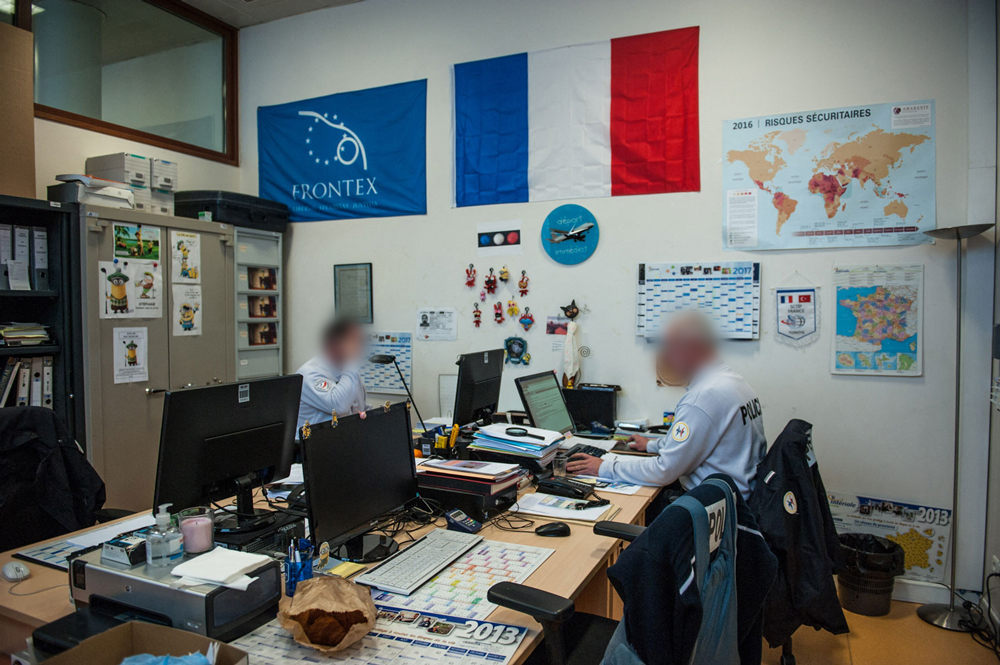
Photo: Julien Jaulin/Hans Lucas
C. Interpreting, or distributing what can be said
15 ZAPI 3 understood as an acoustic environment thus seems to be a pivotal space of “distribution of the sensible” (Rancière, 1995). In this asymmetric acoustic environment dominated by the police, the prospect of forced rerouting is also that of an inarticulate cry. This police system is not simply linked to the institutions that maintain state apparatus, but as in Rancière’s definition, it is linked to the police in “the distribution of place and function and the systems that legitimate that distribution”.
One voice is heard as speech and another as noise
In fact: “The police is, essentially and implicitly, the law, which defines the various parties’ share or lack of it. But in order to define this, we must first define the structure of the sensible in which each has their place. The police is thus first and foremost the body which defines how things are done, where things are placed and what can be said, and which assigns certain bodies by name to a certain place and a certain task; it is an ordering of what can be seen and what can be said which means that one activity is visible and another invisible, one voice is heard as speech and another as noise” (Rancière, 1995: 52).
It is in fact the distribution of interpreting work in the acoustic environment of ZAPI 3 that leads to a voice being “heard as speech” or “as noise”. But this division between a voice in an institutional setting or a cry as the final path of resistance is called into question by the variety of interpreting situations which reassign positions in the acoustic environment of ZAPI 3.
In the perspective opened up by Rancière, we might thus consider these acts as so many deviations from a glottopolice which dominates here. If the term glottopolitics “is needed to encompass all areas of language where the action of society becomes a form of politics” (Guespin and Marcellesi, 1986), then the glottopolice of interpreting would refer to the framework and practices relating to the distribution of sound that make up the administrative and police organisation of the acoustic environment in ZAPI 3. We would then need to understand glottopolitics by contrast with glottopolice, that is, relating to the political reasoning “which suspends that harmony [of the distribution operated by the police] by the simple fact of altering the contingency of the equality, neither arithmetical nor geometrical, of those speaking, whoever they are” (Rancière, 1995: 60). It is this redistribution of positions within the acoustic environment at the border that is produced by the multiple glottopolitical actions of interpreters working in ZAPI 3. This “suspension” of harmony, which demonstrates the “contingency” of the equality of voices, rests on the “subjectivation” of people who refuse the “identification” which is assigned to them. The kind of identification described and rejected by a detainee who, in the Anafé office, said that he would like to “throw [his] nationality in the bin” and that he would accept any offer of “a flight to Mars” or of being “dropped from a helicopter into the sea and end up swimming to America or Canada”. In the face of the radical disappearance of a person assigned an identity they do not accept, glottopolitical interpreting practices appear as possible counterpoints to that police harmony.
next...
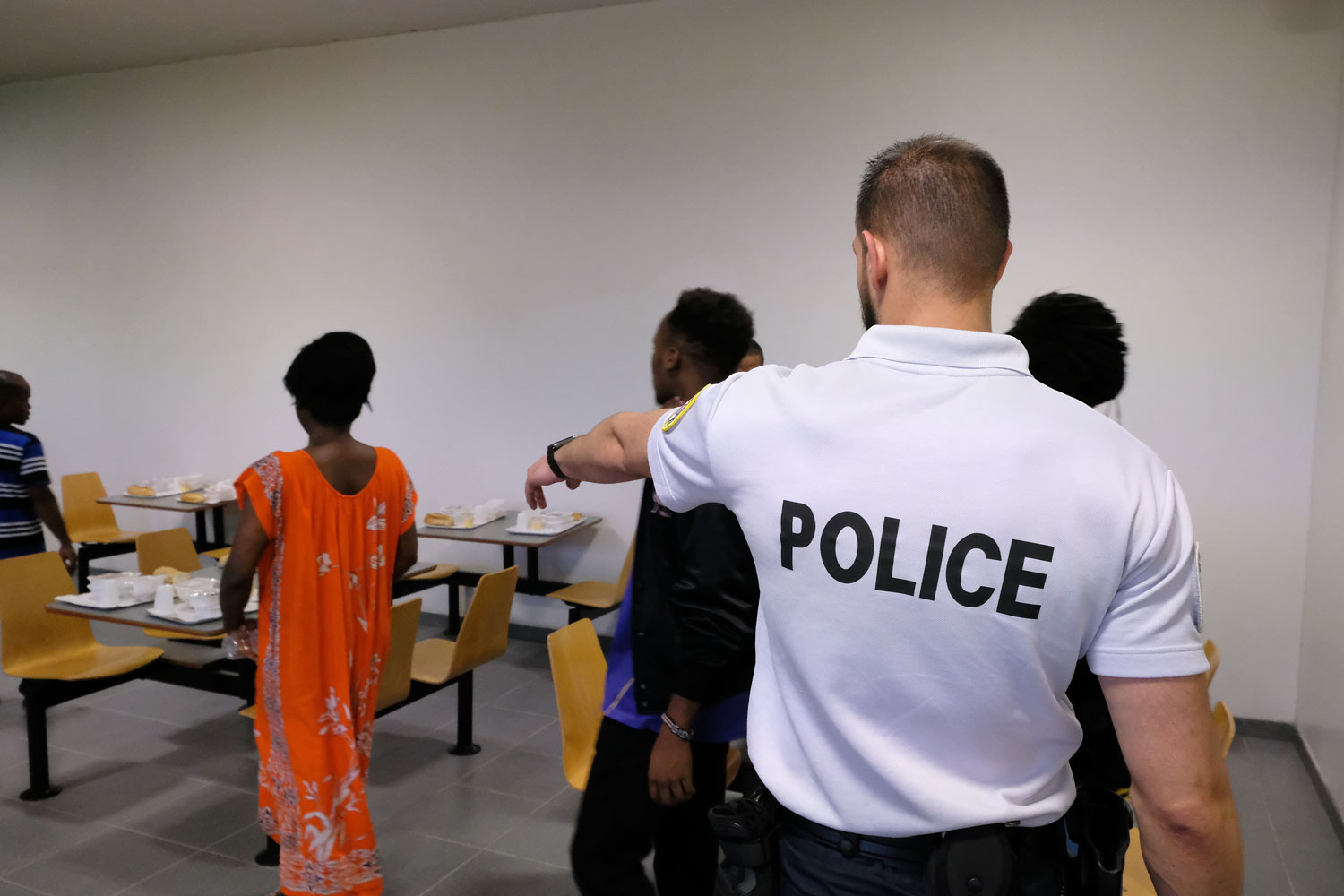
Photo: J.C. Hanché for CGLPL
References
16
ASSOCIATION NATIONALE D’ASSISTANCE AUX FRONTIÈRES POUR LES ETRANGERS (ANAFE), 2018, Aux frontières des vulnérabilités. Rapport d’observations dans les zones d’attente 2016-2017.
———, 2020, Refuser l'enfermement. Critique des logiques et pratiques dans les zones d'attente. Rapport d'observations 2018-2019.
AUZANNEAU Michelle and GRECO Luca (dir.), 2018, Dessiner les frontières, Lyon, ENS Éditions.
BAUDER Harald, 2014, « Why We Should Use the Term ‘Illegalized’ Refugee or Immigrant: A Commentary », International Journal of Refugee Law, vol. 26, n° 3 : 327‑332.
BOURGUET Christian, 1992, « La notion de frontière dans les aéroports ou « le pays de nulle part » », Autres Temps, vol. 33, n° 1: 24‑31.
BRICE Pascal, 2019, Sur le fil de l’asile, Paris, Fayard.
CLAPPE Maureen, 2019, « Interpréter les récits de demande d’asile : une perspective légitimiste et militante du statut de réfugié », Lien social et Politiques, n° 83 : 167‑183.
CLOCHARD Olivier, 2007, Le jeu des frontières dans l’accès au statut de réfugié - Une géographie des politiques européennes d’asile et d’immigration, Université de Poitiers.
D’HALLUIN-MABILLOT Estelle, 2012, Les épreuves de l’asile. De la politique du soupçon à la reconnaissance des réfugiés, École des Hautes Études en Sciences Sociales, Paris.
DJEGHAM Myriam, 2011, Au coeur de l’Ofpra. Demandeurs d’asile et réfugiés en France, Paris, La documentation française.
FASSIN Didier, BOUAGGA Yasmine, COUTANT Isabelle, EIDELIMAN Jean-Sébastien, FERNANDEZ Fabrice, FISCHER Nicolas, KOBELINSKY Carolina, MAKAREMI Chowra, MAZOUZ Sarah and ROUX Sébastien, 2013, Juger, réprimer, accompagner. Essai sur la morale de l’État, Paris, Seuil.
FÉRAUD Olivier, 2010, VOIX PUBLIQUES. Environnements sonores, représentations et usages d’habitation dans un quartier populaire de Naples, Anthropologie sociale et ethnologie, EHESS, Paris.
FERNÁNDEZ-OCAMPO Anxo and WOLF Michaela, 2014, Framing the interpreter. Towards a visual perspective, New York, Routledge.
GALITZINE-LOUMPET Alexandra and SAGLIO-YATZIMIRSKY Marie-Caroline, 2019, « Enjeux de langues et conjonctures en situation migratoire », in Traduction et migration : Enjeux éthiques et techniques, Paris, Presses de l’Inalco.
GUESPIN Louis and MARCELLESI Jean-Baptiste, 1986, « Pour la glottopolitique », Langages, vol. 21, n° 83 : 5‑34.
HAJJAR Lisa, 2000, « Speaking the conflict, or how the Druze became bilingual: a study of Druze translators in the Israeli military courts in the West Bank and Gaza », Ethnic and Racial Studies, vol. 23, n° 2 : 299‑328.
ISERTE Morgane, 2009, « La “crise tchétchène” (décembre 2007-février 2008). Eclairages circonstanciés sur le dispositif de confinement des étrangers dans la zone d’attente de Paris-Charles-de-Gaulle », in Enfermés dehors. Enquêtes sur le confinement des étrangers, Bellecombe-en-Bauges, Croquant.
JACQUEMET Marco, 2009, « Transcribing refugees: The entextualization of asylum seekers’ hearings in a transidiomatic environment », Text and Talk, vol. 29, n° 5 : 525‑546.
MÄÄTTÄ Simo K, PUUMALA Eeva and YLIKOMI Riitta, 2020, « Linguistic, psychological and epistemic vulnerability in asylum procedures: An interdisciplinary approach », Discourse Studies, vol. 3, n° 1 : 46‑66.
MÄÄTTÄ Simo K. and WIKLUND Mari, 2019, « Réparations conversationnelles dans un entretien d’asile interprété par téléphone », Langage et société, vol. N° 166, n° 1 : 161‑183.
MAILLET Pauline, 2020, Nowhere countries : exclusion of non-citizens from rights through extra-territoriality at home, Boston, Brill.
MAILLET Pauline, MOUNTZ Alison and WILLIAMS Keegan, 2017, « Researching migration and enforcement in obscured places: practical, ethical and methodological challenges to fieldwork », Social & Cultural Geography, vol. 18, n° 7 : 927‑950.
MAKAREMI Chowra, 2007, « Vies « en instance » : Le temps et l’espace du maintien en zone d’attente. », Revue Asylon(s), n° 2.
———, 2008, « Participer en observant. Étudier et assister les étrangers aux frontières », in Les politiques de l’enquête, Paris, La Découverte : 165‑183.
———, 2009, « Violence et refoulement dans la zone d’attente de Roissy », in Enfermés dehors. Enquêtes sur le confinement des étrangers, Bellecombe-en-Bauges, Croquant.
MAUGENDRE Stéphane, 2004, « Morts par G.T.P.I.? », Plein droit, vol. 62, n° 3 : 13‑16.
NAVARRO Elisabeth, 2013, L’interprétation-médiation. Approche sociolinguistique et perspectives traductologiques, Université Paris Diderot - Paris 7, Paris.
NAVARRO Elisabeth, BENAYOUN Jean-Michel and HUMBLEY John, 2016, « Une terminologie de référence pour l’interprétation-médiation », in Approches linguistiques de la médiation, Limoges, Lambert-Lucas.
NUČ Aleksandra and PÖLLABAUER Sonja, 2021, « In the Limelight? Interpreters’ Visibility in Transborder Interpreting », ELOPE: English Language Overseas Perspectives and Enquiries, vol. 18, n° 1: 37‑54.
OFFICE FRANÇAIS DE PROTECTION DES RÉFUGIÉS ET APATRIDES (OFPRA), 2021, Rapport d'activité 2020
PIAN Anaïk, 2020, « L’interprétariat à la Cour nationale du droit d’asile : lorsque le récit est transporté par la parole d’un tiers », Terrain et travaux, n° 36/37.
RANCIÈRE Jacques, 1995, La Mésentente. Politique et philosophie, Paris, Galilée.
SPIRE Alexis, 2005, Étrangers à la carte. L’administration de l’immigration en France (1945-1975), Paris, Grasset.
WEITZEL Michelle D, 2018, « Audializing migrant bodies: Sound and security at the border », Security Dialogue, vol. 49, n° 6 : 421‑437.
WOLF Michaela, 2013, « “German speakers, step forward!”: Surviving through interpreting in Nazi concentration camps », Translation and interpreting studies, vol. 8, n° 1 : 1‑22.
next...
Notes
17
1 By the law of July 1992 known as “Quilès”. For a precise and detailed genealogy of the waiting zone, see Maillet (2020) from which I have taken important analyses of the structuring of this area.
2 Used from 2003 in all places where those refused entry may go in the course of their detention (care centres, courts), from 2011 a waiting zone can be set up wherever there is a group of at least ten people categorised as “inad” – i.e. inadmissible, a term introduced by IATA (International Air Transport Association) and regularly used by the French border police – once they have come into the country without passing through a border crossing
3 “le cadrage temporel des délais procéduraux se superpose à celui du quotidien de l’enfermement”
4 Expression used by Anafé. See in particular Makaremi (2007).
5 “cercle vicieux de l’enfermement”
6 “carrières de papier”
7 Zone d’attente pour personnes en instance 3. The number of this area refers to previous waiting zones set up at Roissy-Charles-de-Gaulle airport before ZAPI 3 in 2001, notably in local hotels and the nearby detention centre. I will keep the acronym in French throughout the text to refer to this particular waiting zone.
8 National Association for Border Assistance for Foreigners, which signed an agreement with the Ministry of the Interior in 2004 and has an office in ZAPI 3 in order to supply legal aid to the detainees.
9 Their “mediators” have been present in ZAPI 3 since 2003 and provide “humanitarian aid”, mainly in managing the practical aspects of life for the detainees
10 Despite a great deal of opposition from lawyers’ unions, magistrates and associations defending the rights of foreigners.
11 For ease of expression, the French term for those being held in ZAPI 3 - “personnes maintenues” - will from this point on be translated as “detainees”, although strictly speaking they are classed as being “held” rather than “detained”.
12 “l’invisibilisation des zones d’attente et des personnes qui y sont maintenues”
13 “approches théorico-méthodologiques frontalières, interdisciplinaires, qui entrent ainsi en résonnance avec l’objet qu’elles se proposent d’étudier”
14 In fact, “For foreigners in the waiting zone who do not understand French, administrative authorities only provide an interpreter in the context of the non-admission procedures to which they are subject. In all other cases an interpreter is to be paid for by the foreigner. When the assistance of an interpreter is given by telephone or other means of telecommunication, his name, contact details and the language used are noted in the transcript, a copy of which is given to the foreigner.” CESEDA [Code for the entry and residency of foreigners and the right to asylum], article R343-1.
15 An administrative jurisdiction charged with examining appeals to decisions made by OFPRA (French office for the Protection of Refugees and Stateless persons) in relation to asylum applications they dealt with.
16 Field notebook, 23/10/2020.
17 “proposer la description d’un paysage sonore ni d’étudier les relations écologiques ou bioacoustiques entre des êtres et leur milieu, mais bien de comprendre en quoi les relations sonores peuvent constituer des relations sociales”
18 “une pure géographie entourant les données langagières”
19 Field notebook, duty office 26/11/2021.
20 For “the fear of invaders in short trousers or how to confine children” in the waiting zone, see Anafé (2020: 56-63).
21 Anafé’s duty staff, who contact people in ZAPI 3 via these phones, are able to observe at first hand these frequent and direct interruptions.
22 The French Office for the Protection of Refugees and Stateless people, a public administrative establishment in charge of applying French law and European and international conventions relating to the recognition of a person’s status as a refugee, a stateless person or being in need of protective care.
23 In addition to the different tones of voice used, people’s names are very often pronounced in a way that for them is unusual, not to say caricatural. See especially (Anafé 2018, 2020).
24 ”Biopouvoir”
25 Visits to Roissy-Charles-de-Gaulle airport on 26/05/2021 and 15/06/2021.
26 Adopted by the European Council in 1992 (London resolutions), this stipulated that “A manifestly unfounded application for asylum is one which, in the light of the declarations and any documentation produced by the applicant, is clearly lacking in substance in relation to the conditions under which asylum is granted or lacks any credibility as far as the risk of persecution or serious harm is concerned.” CESEDA, article L352-1.
27 “guichet unique de l’asile”
28 “une véritable usine de prise de décisions” OFPRA administrative archives, DIR 1/52 (“Office Activities”), end of mission summary drawn up by the director (M. Raimbaud), 20/01/2003
29 “Les agents du ministère des Affaires Étrangères (puis de l’OFPRA à partir de 2004), gardiens du droit d’asile en zone d’attente, semblent plutôt travailler dans une logique de gardiens des frontières”
30 Presence at an OFPRA interview, 15/04/2021.
31 That is, recording words in an institutional context in a text (re-transcription): this text is thus disconnected from where it was produced and “reveals how public officials, faced with the intrinsic otherness of asylum seekers, rely on a sometimes inappropriate knowledge, based on common sense, of social, cultural and linguistic values in order to establish, deal with and finally assess the validity of each application.” (Jacquemet, 2009: 525).
32 “l’intéressé utilise un terme en [langue] incompris par l’interprète”, “Incompréhension interprète”. Field notebook, duty office, 17/03/2021
33 “Réponse incompréhensible selon l’interprète” Field notebook, duty office, 27/10/2021.
34 On its website, Anafé asks “volunteer interpreters” to work with the association by emphasising that “All languages are welcome! You don’t need to be a professional interpreter!” The most important thing is competence in the language, with legal training being optional for these volunteers: “Anafé can – at the request of the volunteer interpreter – provide training on the waiting zone and the problems at the border and issue a volunteering certificate.” [my italics] See http://anafe.org/spip.php?article10 (consulted on 11/05/2021).
35 “J’ai expliqué OQTF à Monsieur, parce que ce n’est pas la première fois que je travaille avec des policiers” Field notebook, phone duty 28/08/2021. OQTF (the obligation to leave France) is a decision taken by the chief of police which obliges the foreigner to leave France, by force if necessary, on the expiry of the “voluntary” departure period.
36 “Rerouting” is the border police term for returning a person to the airport from which they came.
37 “Je lui ai donc conseillé de refuser d’embarquer” Field notebook, duty office, 28/07/2021.
38 Field notebook, duty office, 28/07/2021.
39 “englobe à la fois les politiques concertées et les relais, conscients ou inconscients, actifs ou passifs, de ces politiques"
40 “d’englober tous les faits de langage où l’action de la société revêt la forme du politique”
41 “exactement la même chose qu’à Fontenay” Conversation with an interpreter, October 2020.
42 Conversation with an Anafé volunteer, September 2021.
43 “Tu ne peux pas savoir comment est la personne au bout du fil, et là réside une difficulté pour l’interprète d’aborder l’entretien, parce que l’entretien il ne se limite qu’à un rendu auditif, et pour moi en tant que [prénom de l’interprète], même si je fais ce travail, il n’y a pas de souci, je peux le faire, je l’ai déjà fait, j’ai déjà traduit par téléphone, j’ai fait des entretiens téléphoniques… Mais je ne peux pas, humainement parlant, faire ça tout le temps, ça me… Ce serait lourd pour moi d’un point de vue émotionnel” Interview with an interpreter, 27/02/2021.
44 Interviews held on 11/09/2020, 27/02/2021 and 15/11/2021, with three interpreters.
45 Presence at an asylum interview at the border, 13/07/2021.
46 Field notebook, duty office, 01/03/2021.
47 There are, however, reports on this produced by Anafé, as in Anafé (2018: 30; 2021: 190). It is important to emphasise that the frequency of forcible rerouting varies, depending on the waiting zone.
48 See in particular (Anafé 2020) for the testimony of people sent back.
49 “empêcher le raccompagné d’inspirer suffisamment d’air pour pouvoir crier et prendre à partie les autres passagers”
50 Referred to in institutional terminology as “Professional Intervention Techniques”.
51 “partage du sensible”
52 “la distribution des places et fonctions et les systèmes de légitimation de cette distribution”
53 “La police est, en son essence, la loi, généralement implicite, qui définit la part ou l’absence de part des parties. Mais pour définir cela, il faut d’abord définir la configuration du sensible dans lequel les unes et les autres s’inscrivent. La police est ainsi d’abord un ordre des corps qui définit les partages entre les modes du faire, les modes d’être et les modes du dire, qui fait que tels corps sont assignés par leur nom à telle place et à telle tâche ; c’est un ordre du visible et du dicible qui fait que telle activité est visible et que telle autre ne l’est pas, que telle parole est entendue comme du discours et telle autre comme du bruit”
54 “est nécessaire pour englober tous les faits de langage où l'action de la société revêt la forme du politique”
55 “qui suspend cette harmonie [de la distribution opérée par la police] par le simple fait d’actualiser la contingence de l’égalité, ni arithmétique ni géométrique, des êtres parlants quelconques”
56 “jeter [s]a nationalité à la poubelle”, “prendre un vol pour Mars”, “lâché depuis un hélicoptère au-dessus de l’océan et finir à la nage jusqu’en Amérique ou au Canada”. Field notebook, duty office,19/04/2021.
return to the beginning of the article...
https://www.antiatlas-journal.net/pdf/antiatlas-journal-05-marechal-extra-territorial-voices-language-interpreting-practices-in-the-waiting-zone-of-roissy-charles-de-gaulle-airport.pdf


